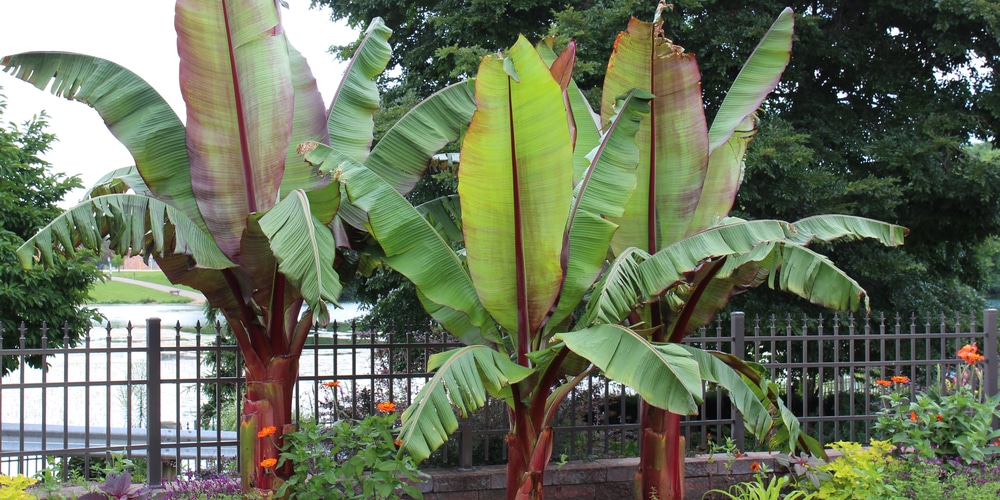Abyssinian Banana is a tropical plant that can add a jungly touch to any landscape. Under the ideal growing conditions, this plant grows fast and can become the focal point of your garden (if you take proper care of it).
However, you must learn what your plant needs and how to fulfill its requirements to get the results you expect. But, do not worry: you have landed in the right place to find out! Keep reading to learn all you need to grow a thriving Abyssinian Banana in your garden.

| Botanical Name | Ensete Ventricosum |
| Common Name | Abyssinian Banana |
| Plant Type | Perennial |
| Flower Color | A large flower bud may appear after a few years of growing the plant. After it, a bunch of banana-like fruits with black seeds will appear. After fruiting, your tree will die. |
| Size When Mature | Up to 6 ft tall and 3 ft wide |
| Bloom Time | Example: Early Spring |
| Sun Requirements | Partial Shade |
| USDA Hardiness Zones | 10-11 |
| Soil PH Range | 5.5 to 6.5 |
| Soil Type | Sandy, rich, well-draining |
| Water Needs | Medium |
| Native Area | East Africa |
What you Need to Know About Abyssinian Banana
Abyssinian Banana belongs to the Musaceae family and is native to East Africa. Despite growing up to 30 feet in height in their natural environments, these plants stay smaller in cultivation. Still, they are impressive species to enhance the looks of your yard.
While not particularly challenging, growing Abyssinian banana includes paying attention to lighting, temperature, moisture, and nutrient content. But once you learn how to master its requirements, you should not have problems growing it.
Luckily, the plant is not toxic, making it a safe option if you have kids or pets running around your garden.
How to Care for Abyssinian Banana
Growing and caring for a thriving Abyssinian Banana takes some patience. Follow the tips we included in these sections, and you should not have issues with this plant.
Light
These tropical plants thrive in full sun to partial shade. Inadequate lighting conditions might hinder its growth and make it more susceptible to attacks from pests and diseases. Pick a location that receives at least 4 hours of direct sun during the day to enjoy your Abyssinian Banana’s beauty to its maximum.
Water and Soil Needs
Plant your banana in rich, well-draining soil. Abyssinian banana is a heavy feeder that requires plenty of water to thrive. However, it won’t do well in soggy conditions.
Don’t forget to adapt your watering schedule to your local climate. For instance, if it’s dry and hot, increase the frequency you add extra moisture to it. To get better results, ensure the soil pH is between 5.5 and 6.5: Abyssinian bananas perform best in slightly acidic conditions.
Temperature Requirements
This plant enjoys the warmth and appreciates high humidity. It will thrive in USDA hardiness zones 10 or 11 with few problems.
However, you can try growing it in other areas, provided you don’t expose it to temperatures below 55°F, to which it won’t likely survive. If you live in an arid region, consider getting a humidifier or commit to misting your plant daily.
Fertilizer
As we mentioned, Abyssinian bananas are heavy feeders. You will have to purchase fertilizer to meet your plant’s nutritional requirements. Get a slow-release product and apply it at the beginning of the growing season. Don’t forget to suspend the application during the winter, when your banana will go dormant.
Common Diseases
Abyssinian bananas can be susceptible to attacks from aphids, whitefly, scale, and mealybugs. If you notice their presence, ensure you take prompt action to eliminate them. Doing so will save you headaches in trying to treat the infestation later.
Additionally, soggy soil and inadequate growing conditions (such as low lighting) might cause the development of fungal infections. Take suitable measures to help your plant recover as soon as possible.
Abyssinian Banana Propagation
One of the best ways to propagate your Abyssinian Banana is to take some black seeds from the inedible fruits. The plant doesn’t produce suckers, making propagation by division a challenging task.
Don’t forget to soak the seeds in warm water before sowing. Allow the seeds to adapt to the environment you choose, and be patient: you might have to wait a couple of months before seeing germination.
Take good care of your seeds to enhance their growth. Water the soil frequently and keep them sheltered from the harsh external conditions.
Related Article: Best Fruit Tree to Grow in Hawaii?
